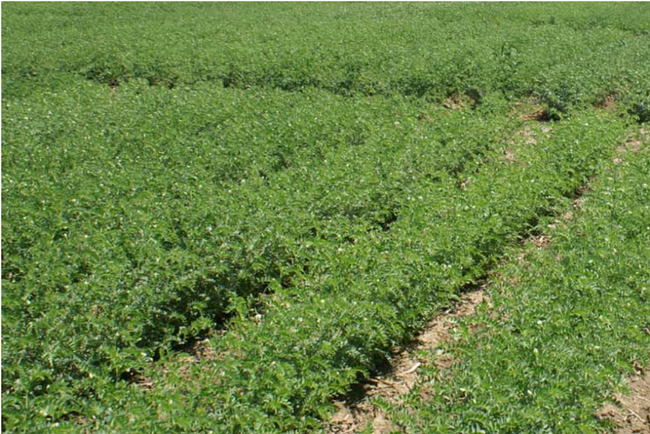“Commodity prices are in the tank.”
“Wheat prices these days don't look so good.”
“Diesel's worth the price of gold, it's the cheapest grain he's ever sold.”
Two quotes from growers I've spoken with, one from a country singer, all relevant points.
Growers looking to diversify their rotations as a way to weather the ebb and flow of the market might consider several alternative crops. Garbanzo beans might fit the bill.
Because of the Central Valley's mild winter, garbanzos can be grown in winter as an alternative to wheat. As a legume, garbanzos can partner with nitrogen-fixing bacteria to produce some of their nitrogen requirement. This is helpful in years like 2016-2017 where frequent rains make it difficult to get into fields for side-dressing applications of N.
When deciding where to plant with garbanzos, there are several things that growers should consider. High-boron soils or wells such as those in certain parts of Yolo county can stunt root growth. Otherwise, heavy rainfall can be problematic for garbanzos particularly on clay soils. Prolonged moisture can make them susceptible to root diseases such as fusarium wilt that often lead to a later collapse under heat stress. As such, bedding for drainage is a must. Exposure to damp conditions for a long period of time can also lead to ascochyta outbreaks.
As with many crops that humans have selected over the years to put arguably silly amounts of work and energy into an oversized food item, garbanzos do not compete well with weeds. This includes the more enthusiastic volunteers. Avoid planting garbanzos after sunflower or safflower, hoeing costs will quickly eat up any potential post-harvest profits. Garbanzos are easier to manage after corn and wheat because volunteers that are not controlled with a pre-plant herbicide can be controlled with herbicides specific to grasses such as Sethoxydim (Poast) or Clethodim (Select Max). Tomatoes are rarely a problem for garbanzos to follow.
With 9,000 acres, garbanzos were the most widely-planted bean crop in our state in 2014. Particularly brutal drought conditions in the winter of 2014-2015 may have played a role in reducing yields to a 2nd place position with 7,200 acres harvested. Garbanzos are currently the best-paying of the pulses coming in at about 42 cents a pound in California relative to black-eyes and kidneys at around 40 cents a pound. Add to that the fact that they need to be grown in the winter, yield roughly 1.5 tons/ acre, and are adept at mining the soil for deep water, and it becomes clear what some of the reasons for the expanded acreage might be.
Even with the growth over recent years, the market for garbanzos in California is, as expected, relatively segmented and not as widely developed as more mainstream crops such as wheat and alfalfa. There are several confirmed processors and contractors of garbanzos that growers should get familiar with if they are thinking about growing in the Sacramento and San Joaquin Valley.
Cal-Bean and Grain is a cooperative located in Pixley (Tulare County) that cleans and processes garbanzos after harvest. Chad van der Feer is the general manager.
Contact: Chad, 559.757.3581
Email: chad at calbean.com
Dompe Warehouse processes garbanzos for David Kirsten in Crow's Landing (Stanislaus County). David manages contracts through Kirsten Company LLC. David is seeking additional contracts as of this posting.
Contact: David Kirsten, 209.747.1100; Dompe Warehouse, 209.837.4725
Email: dave at kirsten.com
Rhodes-Stockton Bean Co. located in Tracy is a co-op/ processor that works closely with Cal Bean and Pea's Joel Parreira. For growers farther north, they have a separate warehouse in Meridian (Tarke Warehouse). They are seeking additional members/ contracts as of this posting.
Contact: Rhodes Stockton, 209.835.1284; Cal Bean and Pea, 559.685.9491
Email: ken at beanplant.com
Sutter Basin Co-op is based in Knight's Landing (Yolo County). They work with Steve Benson of Northwest Trading but are currently not seeking additional members/ contracts.
Contact: 530.735.6295
Additional warehouses and dealers can be found at: http://www.calbeans.org/bean-board/, although those not listed above may not process garbanzos (based on information available at the time of writing this).
While growing garbanzos is not the same as growing wheat, it is a sound choice for growers looking to diversify amid some painful commodity prices.
Growers considering planting garbanzos should keep an eye out for the upcoming UC ANR Garbanzo Production Handbook. Speak to the UCCE Agronomy Advisors in your local counties for more information in the meantime.
Growers with garbanzos in the ground should also feel free to reach out to advisors if they see disease or stress cropping up in their acreage. Heavy rains this year will likely reveal some insight into how resistant current varieties are being impacted by water logging.
